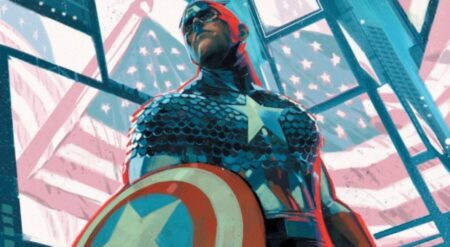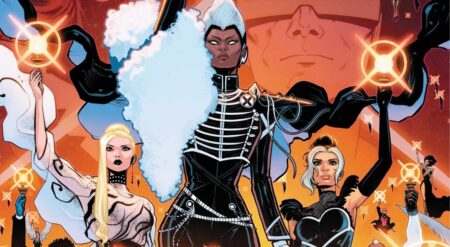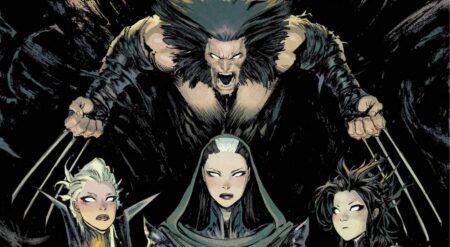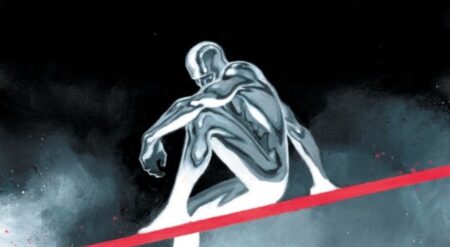Uncanny Avengers #1 is published by Marvel, written by Gerry Duggan, art by Javier Garrón, colors by Morry Hollowell, and letters by Travis Lanham. One page of a backup story is written by Jonathan Hickman with the same art team. A mysterious figure called Captain Krakoa has been attacking Captain America and other humans, raising suspicion and fear of Mutants. So Cap starts to form a new Avengers Unity Squad…
This is a bumper-sized issue that feels warranted and fills the power of the book excellently. The X-Men books’ current mood seeps into this Avengers book, battling many of the problems head-on. The opening of the issue introduces Psylocke and Penance into an Avengers comic, unleashing a vengeance slaughter on Orchis before Captain America intervenes. It demonstrates a mad panic among the X-Men who are grieving and in shock but do not entirely know what to do. Cap begins gathering the team in a book that has a slow but investing pace. There is a mystery character also collecting members for a team, and it makes the impression of numerous factions all scheming and planning that will eventually collide.
This issue is also a great release of energy, as the team is making a stand and fighting against an oppressive and fascist force that can twist and lie its way into favor among the public. The team is gradually brought together, with the older, more recognizable faces of the Unity Squad entering last. The book feels heavy and important while there is superhero action and general excitement around the issue. It concludes with the start of a brutal battle, with a shocking and gruesome injury being the moment that Duggan chooses to end. It demonstrates the forceful impact the series could have
The characters in the opening issue of Uncanny Avengers #1 are fascinating, with a bizarre structure to the cast being formed. There is an initial team, and it is surprising who has been selected. Everyone bar Captain America, is someone who I would associate heavily with the X-Men, although they may not necessarily be mutants. For a figure like Quicksilver, the retconning of his origin took the Mutant part away from him, and Deadpool has certainly been involved with X books for decades, although he and Pietro both have a history with Cap.
Rogue has become the primary member of the Unity Squad. Psylocke and M are brilliant inclusions as they thrive on fighting and chaos, which an Avengers story can often devolve into. It’s a small squad, which can make the relationships within them more intense and involved. But there is also a supporting cast, with both humans and mutants making cameos towards the end of the issue, that will play a role in trying to retaliate against the Stark Sentinels and Orchis.
The narration and captions within the comic can be particularly confusing. It opens with Ben Urich, who provides an extensive synopsis of what has happened with Captain Krakoa, Orchis, and the treatment of mutants. He even starts talking about individual members of the new team. However, this is then switched halfway through, and an unknown, more godlike narrator takes over that accesses the mindset of Captain America. It’s not a derailing change, but the lack of a known voice for the second set of captions makes it slightly jarring.
The art is superb. The location and the atmosphere in the book are incredible. This is most prominent in the first scene, where Mutants are offloaded into a gloomy holding center for mutants captured by Orchis. This part of the comic is purposefully murky, with extremely heavy line weights and shadows.
The rest of the comic has thinner lines, and the style of Garrón shows terrific adaptability. The characters all look excellent, with the separate body shapes of the differing heroes making many of them easy to identify even if they were only silhouettes. There are some panels that show reflections in objects that aren’t just plain glass, and it is jaw-dropping to see that execution. The design of Captain Krakoa, the book’s main villain, is corny but brilliantly points figures what is openly being suggested as a red herring. The locations themselves are stunning. New York has a mesmerizing level of detail to it when it is first shown.
But it should be noted that there are some brief panels where the art doesn’t always look right. Certain angles in which the characters are placed can lead to them looking off. It happens numerously with Psylocke and her angular face, but Ben Urich’s introductory panel presents him as twisted or awkwardly positioned at least. In addition. The first fight ends with a burning blaze which highlights that unnerving element of the art. Captain America’s eyes are haunting, boring through the haze with a definition that isn’t quite matching the rest of the panels.
The colors are extraordinarily effective in this issue, again fluctuating and adapting with the art. The first moments at the Orchis facility are dark and somewhat difficult to make out, with some bright spotlights getting drowned by rainwater. It makes the whole thing deliberately unpleasant and menacing. But as the issue progresses, the colors resort to a palette for a crossover superhero team, filled with rich shades and vibrant tones of red, green, blue, purple, and many others. The lettering is the standard font that is used in all X books, which is interesting considering the Avengers title.
Uncanny Avengers #1 brings the Unity Squad back when needed most. An important issue that brings an Avengers perspective to the catastrophic mutant situation. It has often been leveled at Captain America and others that they don’t get involved when the need to, so this book seeks to change that. Duggan makes an opening issue with weight and emotion and laces it with intrigue and characters behind imperceptible masks. The team feels fresh, not just a rebuild of mainstays and unoriginal ideas. And the art is simply ridiculous at points. That ability to change the style and the utterly unfathomable location details gives the book a really distinctive look.
Uncanny Avengers #1 is available where comics are sold.
TL;DR
Uncanny Avengers #1 brings the Unity Squad back when needed most. An important issue that brings an Avengers perspective to the catastrophic mutant situation.







